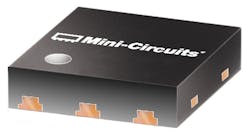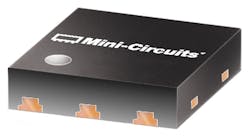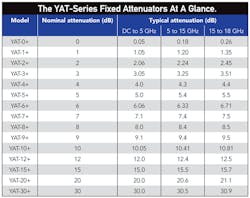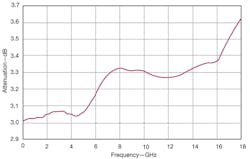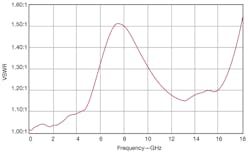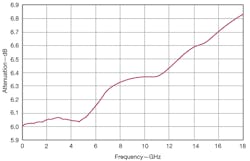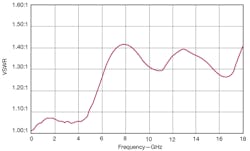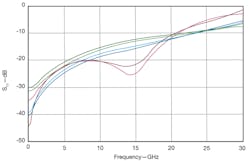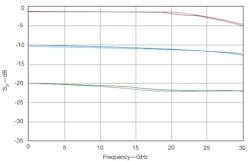Attenuation has saved many systems and circuit designs, especially when it can be added in precise, consistent amounts. Attenuation comes in many forms and sizes, but perhaps few packages that are smaller than the new 2 x 2 mm chip-sized YAT-Series fixed attenuators from Mini-Circuits. Available in 1-dB increments from 0 through 10 dB, and with as much as 30-dB attenuation packed into that tiny housing, these miniature fixed attenuators are actually fabricated with an advanced semiconductor process for consistency.
With a frequency range of DC to 18 GHz, the YAT-Series fixed attenuators can serve a wide range of commercial, industrial, and military applications, including cellular and wireless communications systems and in radar and electronic-warfare (EW) equipment. In spite of the diminutive size, the fixed attenuators can handle as much as 2 W (+33 dBm) power while still effectively dissipating any heat generated as a result of the RF/microwave power.
The YAT-Series attenuators (Fig. 1) are miniature 50-Ω passive components that can be added to a design to reduce signal levels, to increase isolation between different sections, or to improve impedance-match and return-loss performance. They are available in attenuation values through 30 dB, with minimal attenuation above and beyond their rated attenuation values.
1. YAT-Series fixed attenuators are supplied in a tiny surface-mountable package measuring just 2 mm x 2 mm.
The fixed attenuators are fabricated with a gallium-arsenide (GaAs) monolithic-microwave-integrated-circuit (MMIC) semiconductor process using thin-film resistors that exhibit consistent characteristics over a wide temperature range. The YAT-Series fixed attenuators are designed to handle operating temperatures from -40 to +85°C with minimal variations in rated attenuation values over temperature and over frequency. In terms of attenuation as a function of temperature, attenuators of all types will exhibit increasing loss with frequency resulting in some increase above nominal rated attenuation value as frequency increases. The YAT-Series attenuators are no different (see table), with slight increases above the nominal rated attenuation value for each model across the highest portion of the frequency range (15 to 18 GHz).
To achieve a maximum power rating of 2 W from DC to 18 GHz for such small passive devices, the YAT-Series attenuators were designed using sound thermal-management practices. To augment the dissipation of power though the silicon substrate material, the thin-film resistors used in the YAT-Series attenuators employ copper-metallized viaholes to create a reliable thermal path from the resistors to the MMIC ground plane and package base. Not only does the proper thermal management ensure good long-term reliability, but it also contributes to the consistent attenuation with temperature, frequency, and input power for the YAT-Series fixed attenuators.
In communications, radar, EW, and other broadband, high-frequency systems, it is often necessary to drop the power level at the input of an amplifier or decrease the output level of an oscillator, and one of the easiest level adjustments is simply to drop the signal levels at a critical point in a system or circuit by one-half the power. As a result, 3-dB attenuators are among the more popular attenuation values in high-frequency circuits and systems—including in test equipment—because of the simplicity of reducing the power level by one-half the known level.
The YAT-3+ is a 3-dB attenuator that provides consistent attenuation across its wide DC-to-18-GHz frequency range at a cost ($2.99 each USD in quantity of 20) that will fit most budgets. When characterized at room temperature (+25°C) through swept-frequency measurements in a coplanar-waveguide (CPW) test fixture, it exhibits the expected trend of rising attenuation with frequency (Fig. 2). The measured minimum attenuation for the model YAT-3+ fixed attenuator is 2.80 dB from DC to 5 GHz, 2.90 dB from 5 to 15 GHz, and 3.00 dB from 15 to 18 GHz.
2. As characterized in a CPW fixture, the attenuation for the YAT-3+ 3-dB fixed attenuator was measured from DC to 18 GHz.
The measured maximum attenuation for the YAT-3+ is 3.3 dB from DC to 5 GHz, 3.8 dB from 5 to 15 GHz, and 4.0 dB from 15 to 18 GHz. The YAT-3+ also maintains low VSWR across its operating frequency range (Fig. 3), with typical VSWR of 1.15:1 from DC to 5 GHz, 1.48:1 from 5 to 15 GHz, and 1.54:1 from 15 to 18 GHz. It maintains maximum VSWR of 1.25:1 from DC to 5 GHz, 1.70:1 from 5 to 15 GHz, and 1.90:1 from 15 to 18 GHz.
When more than a 3-dB drop in power is necessary, a 6-dB model such as the YAT-6+ can be very useful, allowing for a doubling in attenuation without occupying any more space in the design than the 3-dB attenuator. The YAT-6+ is rated for 6-dB attenuation from DC to 18 GHz, with attenuation that remains extremely flat at the lower frequencies. It only exhibits the expected increase in attenuation with frequency above about 6 GHz (Fig. 4).
3. The VSWR of the YAT-3+ fixed attenuator was measured from DC to 18 GHz.
When characterized at room temperature with the CPW test fixture, the YAT-6+ demonstrated measured minimum attenuation of 5.6 dB from DC to 5 GHz, 5.8 dB from 5 to 15 GHz, and 6.0 dB from 15 to 18 GHz. The measured maximum attenuation for the YAT-6+ is 6.4 dB from DC to 5 GHz, 6.9 dB from 5 to 15 GHz, and 7.3 dB from 15 to 18 GHz. The typical VSWR for the YAT-6+ fixed attenuator (Fig. 5) is 1.15:1 from DC to 5 GHz, 1.42:1 from 5 to 15 GHz, and 1.50:1 from 15 to 18 GHz. As with the YAT-3+, the maximum VSWR for the YAT-6+ is 1.25:1 from DC to 5 GHz, 1.70:1 from 5 to 15 GHz, and 1.90:1 from 15 to 18 GHz.
4. Also characterized in the CPW fixture, the attenuation for the YAT-6+ 6-dB fixed attenuator was measured from DC to 18 GHz.
Another popular attenuation value is 10 dB, or the model YAT-10+ with a nominal rating of 10-dB attenuation from DC to 18 GHz. When connected to the test fixture with CPW input and output traces, the YAT-10+ measures maximum attenuation of 10.5 dB from DC to 5 GHz, 11.0 dB from 5 to 15 GHz, and 11.5 dB from 15 to 18 GHz. It offers very well-behaved VSWR characteristics, with typical VSWR of 1.15:1 from DC to 5 GHz, 1.48:1 from 5 to 15 GHz, and 1.67:1 from 15 to 18 GHz.
The maximum measured VSWR is 1.25:1 from DC to 5 GHz, 1.70:1 from 5 to 15 GHz, and 1.90:1 from 15 to 18 GHz. This makes the YAT-10+, as with all of the YAT-Series fixed attenuators, an excellent choice for broadband impedance-matching applications.
5. The VSWR of the YAT-6+ fixed attenuator was measured from DC to 18 GHz.
One of the more intriguing models in the YAT-Series lineup is the 0-dB YAT-0+ fixed attenuator. In theory, boasting a 0-dB attenuator helps improve isolation and impedance match in a circuit or system (as evidenced by a reduction in the VSWR) without significant penalty in signal loss. For broadband applications, it is vital that such an attenuator maintains consistent electrical characteristics across frequency and temperature. As to be expected, the YAT-0+ attenuators exhibit some increase in insertion loss with frequency, with maximum attenuation of 0.2 dB from DC to 5 GHz, 0.4 dB from 5 to 15 GHz, and 0.5 dB from 15 to 18 GHz. The typical VSWR remains low, at 1.20:1 from DC o 5 GHz, 1.34:1 from 5 to 15 GHz, and 1.60:1 from 15 to 18 GHz.
Highly accurate electronic-design-automation (EDA) models of the YAT-Series attenuators have been developed by modeling specialists Modelithics. These models are now part of Modelithics’ expanding library of Global Models™ for simulating passive circuit elements and components. To ease integration of YAT-Series precision attenuators into a circuit design, the Modelithics models are available free of charge from the Modelithics’ Vendor Partner (MVP) online landing page for Mini-Circuits.
6. Free-of-charge simulation models available from Modelithics for the YAT-Series attenuators provide simulated S11 and S21 magnitude responses almost identical to measured performance through and above the specified upper-frequency range, as shown here for 1-, 10-, and 20-dB attenuators measured and modeled from DC to 30 GHz.
These attenuation-value-scalable models are extremely broadband, covering DC to 30 GHz, with modeled S11 and S21 characteristics almost identical to measured responses for all attenuation values (Fig. 6). These YAT-Series attenuator models include dielectric and ground effects for popular circuit materials—such as RO4350B™ laminates from Rogers Corp.—and are designed to simulate the behavior of the attenuators in microstrip and grounded coplanar-waveguide (CPW) applications. The attenuator models are currently available for two of the more popular RF/microwave software simulation programs: the Advanced Design System (ADS) software from Agilent Technologies and Microwave Office from AWR Corp.
The YAT-Series fixed attenuators all feature a maximum power rating of 2 W, a small size of 2 x 2 mm, 50-Ω characteristic impedance, and operating temperature range of -40 to +85°C. All YAT-Series fixed attenuators are RoHS compliant. They have electrostatic-discharge (ESD) ratings of 250 V, Class 1A, per the human body model (HBM) and 200 V, Class B, per the machine model (MM). The miniature fixed attenuators can be supplied in quantities as small as 20 per reel or as large as 2000 per reel, on 7-in. reels for use with automated pick-and-place assembly equipment. All YAT-Series attenuators meet the applicable requirements of MIL-STD-202, MIL-STD-750, and MIL-STD-883 for hermeticity, acceleration, vibration, mechanical shock, and temperature cycling.
Mini-Circuits, Inc., P.O. Box 350166, Brooklyn, NY 11235-0003; (718) 934-4500, FAX: (71) 332-4661, www.minicircuits.com.
